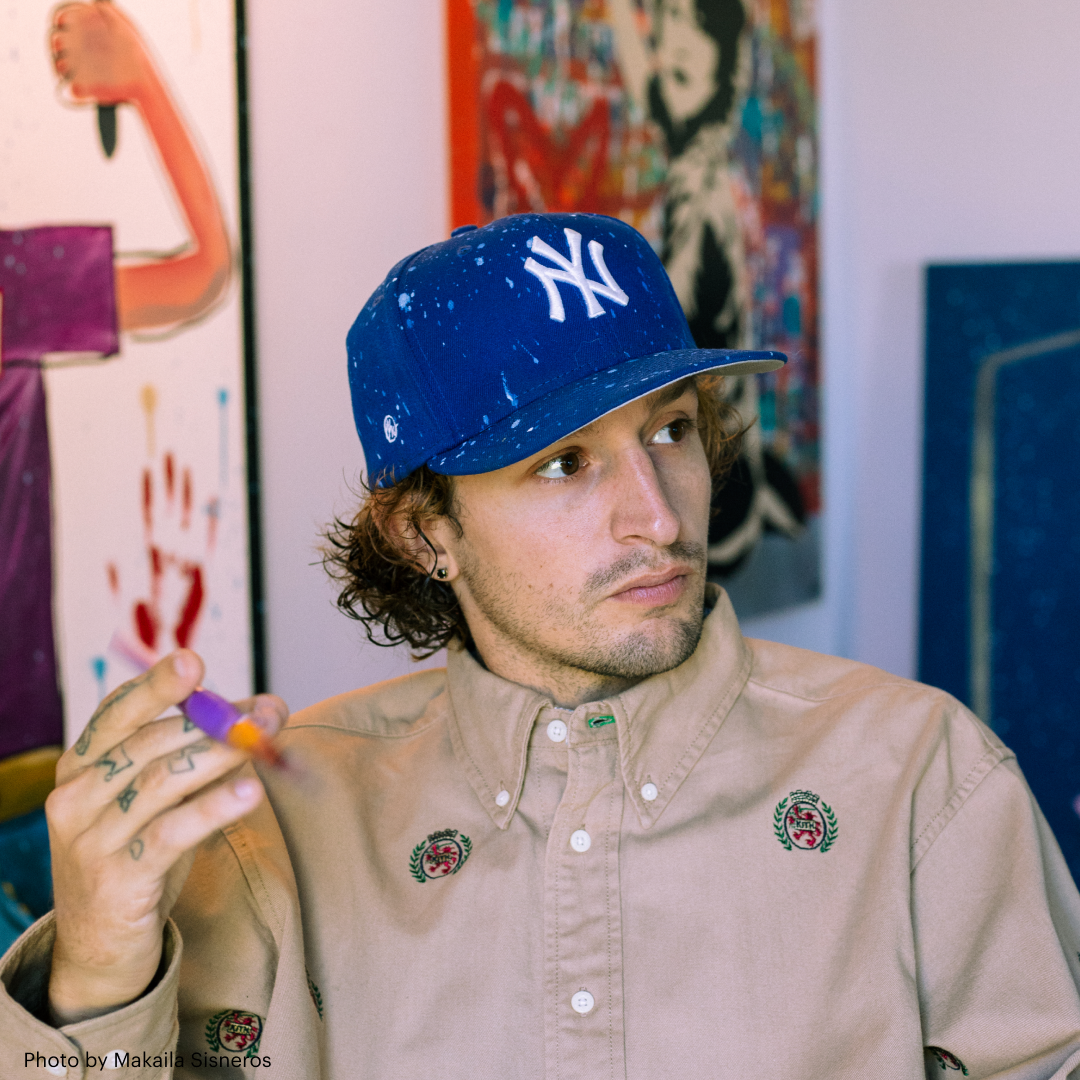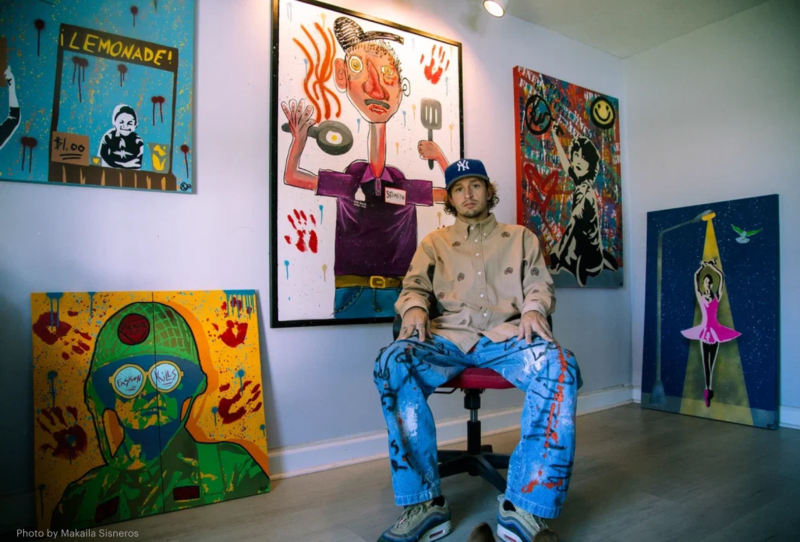
Five years ago, following a Parotid gland cancer diagnosis and two subsequent surgeries to the left side of his face, KW began his journey in painting. After returning from the hospital to his East 7th St. and 1st Avenue Manhattan apartment, he stumbled upon an easel that would launch his artistic career. Passing the building’s garbage, KW was struck by this easel and brought it to his apartment, finding the new urge to paint. Since then, he has created a diverse array of artworks, ranging from graffiti to multimedia sculptures and oil paintings.
Fine Art Shippers spoke with KW about his evolution, his favorite themes, and the inspiration behind his art, providing others with hope.
Artist Talk: Kyle Wallack (KW) on Robots, Fashion and Amazon
How did you start making art while recovering from surgery, and what was the initial impulse? What was your first painting?
Kyle Wallack (KW): While I was battling cancer, I had been in and out of the hospital for various surgeries; I was constantly connected to health monitors to track my progress. This gave me the first idea to paint a robot with wires coming out of its head and heart to express the difficulties I was facing mentally, physically, and emotionally during my recovery. Robots remain a recurring theme in my artwork to this day, to commemorate my fight and the inspiration behind my works. Later, I found myself drawn to the cartoon character Winnie the Pooh. Painting scenes of Pooh brought me a sense of comfort and nostalgia during the hardest phase of my life. My first gallery exhibition, on Orchard Street in New York’s Lower East Side, featured some of these robot and Pooh-themed paintings, paying homage to my journey.
Later, I started diving into graffiti and would find myself painting graffiti-style murals throughout East Village and Lower East Side. During the early part of 2022, I pushed myself to expand my creative talents. I was challenging myself to be uncomfortable in what I was creating; I never wanted to be an artist who was restricted to a certain set of mediums or put in a creative box. This was when I started exploring various styles of art. Even recently, I began working with oil paints, which used to scare me and seemed daunting. Although I am not technically trained in fine art, I’ve now created a couple of oil paintings that are totally different from anything else I have made previously. The new medium has given me more freedom to express my ideas and advance my technique in new and different ways. There will be exciting creations ahead, so stick around to see what’s to come!
Can you talk more about some of your recent and current projects? What inspires you?
Inspiration for my artworks is directly related to my personal life, experiences, philosophy, and political commentary. For example, I created a 30-piece series called “Pigments of Sound” dedicated to the musical influence and rockstars of the 1970s and ‘80s. To me, those musicians represent the last real rockstars; they impacted me tremendously growing up. I love the attitude of the artists from the ‘70s and their influence on modern culture. This series was cultivated with an appreciation for the era and its musicians. This collection was on display at Quidley and Company Fine Art last October and I’m extremely proud of it.
Other forms of inspiration derive from my family and their influence on my journey thus far. Recently, I painted a picture of my dad, visually inspired by Basquiat’s “Joe.” I was inspired by this painting because I know the chef that this painting was modeled after, which I connected back to my father, also a chef, who has played a critical role in my life. Therefore, I felt the need to create my own piece, commemorating him and attributing some of my achievements to the man who raised me.
You also have a series of painted bikes. How did you get this idea?
Before I got into painting, in my Junior year at Endicott College, I started a clothing company. This company allowed me to become familiar with Adobe Illustrator and Photoshop, leveraging my skills as a Marketing major to enhance and perfect my craft. My first forms of art began as designs on T-shirts and hoodies. The idea for the bike series came up when my friend and I, just for fun, decided to splatter paint on a red bike we had.
I thought it would bring a cool aesthetic to the background of the shoot and realized I had a totally new and different medium for art. This piece caught the attention of the 375 Showroom, located on the Lower East Side. They asked me to transform a bike for them, which resulted in the “Bike of Life,” a piece adorned with butterflies, flowers, and small sculptures defining the vibe and influence of New York.
I then built a crime scene installation around the original red-splattered bike. This shocking piece, wrapped in caution tape and crushing a mannequin’s leg, reflects the dog-eat-dog world we currently live in. During the 2020 protests in NYC, I painted a city bike with scenes from my apartment windows. Burning cop cars, trains, and the front of the bike featuring two protesters—it was very important to me to capture the emotions of the moment in New York City. Now, I’m working on several more bike projects, including one that will be equipped with a fully painted surfboard.
What does your creative process look like? What sets you in the creative mode?
Before I start a new series, I thoroughly research the idea or topic of interest and then I begin to paint. For instance, for my “Pigments of Sound” series, I spent nearly two weeks reading musicians’ biographies and books on rock history to fully grasp their impact on the time period.
While creating graffiti pieces, I begin by digitally manipulating images in Photoshop and Illustrator to develop a clear vision for the final product. For oil paintings, I first sketch out my ideas on paper to plan the composition and then use this as a guide for my works. Overall, I prefer to be free-flowing and not have an overly rigid creative process that would stifle innovation.
What subjects are you interested in exploring in your art?
I spend a great deal of time observing and analyzing my life and its impact on society. This is ultimately where the subjects of my artworks come from. In my “War on Fashion” series, I combined the visual elements of World War II propaganda with those of high fashion brands to express the chokehold high fashion continues to have on society.
During the pandemic, I saw my father, a chef, struggle to keep his business afloat. Meanwhile, Amazon deliveries were a common sight on every corner. This disparity inspired me to create a series featuring local businesses. In one piece, an Amazon plane is dropping a bomb on a child’s lemonade stand with a man holding a sign reading “support local business.” This is meant to reflect the demise of local businesses at the behest of large corporations. Being a small business owner myself, I seek to convey the struggles of average people and their strife to challenge the status quo, act with humility, and create something that will last forever.
How do you promote yourself as an artist? Do you have a strategy?
I will admit, at times I have struggled to connect with galleries and collectors. A challenge faced by all rising artists, at least the honest ones, I get my message out by creating art that spreads hope. Although the story of my battle with cancer is inspiring, it certainly is not unique. My art is intended to show others that through pain and hardship, joy and tranquility can be achieved. I was able to take the suffering of my illness and create pieces of art and a message that will hopefully last forever.
Things first changed when I attended a local event to sell clothing from my fashion brand. I brought along some of my very small, original robot paintings to decorate the stand and attract potential customers by showing my creative range. After a short period of time, to my complete surprise, four of these tiny paintings were sold. Although I never intended to sell these hand-crafted works, I was so proud that someone was willing to pay for them, I simply said “Ok, $40 piece.”
Needless to say, the event inspired me to take my art more seriously. I began creating larger pieces, sharing my process online and building a following on social media platforms like Instagram (@kw.refinedgraffiti). I then hosted exhibitions in my Chelsea studio space, to engage others and display my work more broadly. I’m beyond grateful for the tremendous support from my local community which has continued to benefit me to this day.
Three years after relocating to Florida, I decided to dedicate myself full-time to my art career. I spent a lot of time reaching out to galleries and collectors, making connections. It took roughly a year of persistent outreach to attract Quidley and Co. Fine Art, who expressed interest in representing me. Following a successful show in their Connecticut space, I’m now organizing a major solo exhibition in the Tampa Bay area, titled “Refined Graffiti”’ showcasing my work from the past five years.
I appreciate the opportunity to speak with you and spread my message of hope to the masses, thank you!
Interview by Inna Logunova
Photo courtesy of Kyle Wallack
To connect with KW:
thekwgallery.com
instagram: kw.refined graffiti
email: thekwgallery@gmail.com

